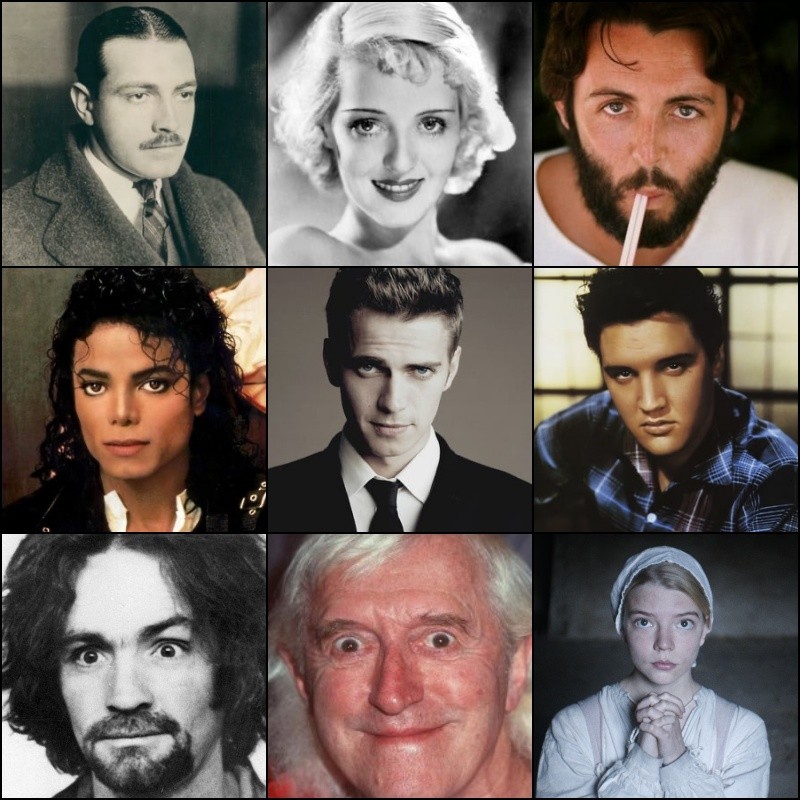Have you ever looked closely at someone's eyes and noticed something a little different, a subtle glimpse of white that seems to extend beyond the usual? That, you know, could be what some people call sanpaku eyes. It's a feature that has, in a way, captured curiosity for a very long time, especially when it appears on public figures we often see in magazines or on screens.
Sanpaku, a term from the Japanese language, literally means "three whites." It refers to a situation where you can see the white part of someone's eye, either above or below the colored iris. Normally, that's a pretty unremarkable thing that you might not even be able to pick up on, yet, in some traditions, it carries quite a bit of weight.
For centuries, people have looked to the eyes for clues about a person. In traditional Chinese and Japanese face reading, the eye is composed of two parts, the iris and the surrounding white. When that white shows in an unexpected way, especially on well-known individuals, it often sparks conversations and, perhaps, a little bit of speculation about their lives.
Table of Contents
- What Are Sanpaku Eyes?
- The Cultural Significance of Sanpaku
- The Public Gaze: Sanpaku Eyes and Well-Known Figures
- Frequently Asked Questions About Sanpaku Eyes
What Are Sanpaku Eyes?
Sanpaku refers to a Japanese term and superstition. It interprets the visibility of the white space above or below the iris as an indicator of an individual’s physical and emotional imbalance. So, it's not just about how the eye looks, but what that look might suggest about the person themselves.
When you can see the white of somebody's eye either above or below the iris, that's what we call sanpaku. As a matter of fact, it's a visual characteristic that some people might not even notice at first glance. It's subtle, but for those who understand the concept, it can be quite striking, in a way.
The term itself, sanpaku, comes from the Japanese language meaning “three whites.” This refers to having additional white space visible above or below the iris. It’s a specific way of seeing the eye that has, you know, gained some recognition over time, particularly in certain cultural contexts.
While this description may conjure a spooky visual for some, they're actually quite common, and you likely know someone with this eye shape. It's not something rare or unusual, but rather a feature that, when understood through the lens of traditional beliefs, takes on a different kind of importance.
In Japanese face reading, sanpaku eyes are considered more than an aesthetic feature. They offer clues about our emotional state, physical health, and spiritual path. This means that, for practitioners of this art, the eyes become a window into a person's inner world, providing insights that go beyond just appearance, you know.
The Cultural Significance of Sanpaku
According to traditional Chinese and Japanese face reading, the eye is composed of two parts, the iris and the surrounding white. When the white part of the eye shows in an unusual way, it's not just a physical trait; it carries a deeper meaning. People with sanpaku eyes are often considered unfortunate and viewed as potentially troubled, so it's a belief that carries some weight.
This belief suggests that a person with sanpaku eyes might be experiencing some kind of imbalance. This imbalance could be on a physical level, or perhaps an emotional one, or even a spiritual one. It's a way of interpreting a person's appearance to gain insight into their overall well-being, which is, you know, a very old tradition.
Sanpaku eyes are associated with tragedy and violence in some interpretations. This doesn't mean that everyone with this eye shape will face misfortune, but rather that the belief system links this visual trait to certain life paths or experiences. It's a superstition, yes, but one that has been around for a very long time, shaping how some people perceive others.
In Japan, there's a particular term for such eyes, and it's part of a broader system of face reading. That doesn't mean that Tokyoites stride around staring at each other's faces and scrutinizing the quantity of white in their eyes, but the concept is certainly part of the cultural fabric, you know, a bit like other folk beliefs.
Yin Sanpaku and Yang Sanpaku
People with sanpaku eyes typically fall into one of two categories. These categories help to refine the interpretation of what the visible white might mean for an individual. It's not a one-size-fits-all kind of reading, but rather a more nuanced approach, so.
One category is Yin sanpaku, or white under the iris. This is believed by practitioners of traditional Japanese face reading to signal physiological turmoil. This turmoil might be owing to drug abuse or overindulgence, and may hint at various struggles a person might be going through. It suggests an inner struggle that manifests, in a way, through the eyes.
Individuals with yin sanpaku have this white space visible below the iris. This particular presentation is often linked to internal issues, things that might be happening within a person's body or mind. It's a subtle sign that, according to these traditions, points to a need for balance and well-being, you know, a sort of warning sign.
The other category is Yang sanpaku, which is when the white of the eye is visible above the iris. While "My text" does not go into detail about Yang sanpaku, in traditional face reading, it is often associated with a different kind of imbalance, perhaps related to mental or emotional instability, or a person who might be seen as dangerous or prone to violence. It's a different kind of tension, you see.
These distinctions are important for those who practice face reading. They provide a more specific way to interpret the meaning behind the sanpaku appearance. It's like having different shades of meaning for a single concept, allowing for a more precise reading of a person's state, you know, a bit more detail.
Sanpaku in Popular Culture
The concept of sanpaku eyes has also found its way into popular culture, particularly in certain forms of entertainment. It's not just an old superstition; it has, in a way, become a visual shorthand for certain character traits.
In manga iconography, sanpaku eyes are used to make a character seem dangerous or threatening. This visual cue helps to convey a sense of unease or power around a character, even before they speak or act. It's a clever way to use a subtle physical trait to communicate something significant about a character's nature, so it is.
This use in manga shows how a traditional belief can be adapted and reinterpreted for a different medium. It highlights the lasting impact of such concepts, even if they are used in a fictional context. People recognize the visual, and it carries a certain weight, you know, a kind of unspoken message.
Sanpaku eyes are also known as three eyes in Japanese culture. While this description may conjure a spooky visual, they're actually quite common. This commonness doesn't stop the fascination, especially when people see this trait in public figures. It just goes to show how a simple physical feature can become quite interesting when viewed through a cultural lens.
The idea that eyes can reveal so much about a person is a powerful one. Whether it's through traditional face reading or through the dramatic portrayal in manga, the concept of sanpaku eyes continues to intrigue people. It's a reminder that sometimes, the smallest details can hold the biggest stories, you know, in a rather compelling way.
The Public Gaze: Sanpaku Eyes and Well-Known Figures
The fascination with sanpaku eyes often peaks when people observe this feature on celebrities and other well-known figures. It’s almost as if the traditional interpretations of sanpaku become more pronounced or more discussed when applied to those in the public eye. People tend to look for signs and meanings in the appearance of famous individuals, you know, perhaps more than they do with everyday folks.
When someone famous is believed to have sanpaku eyes, it often sparks conversations online and among fans. People will sometimes scrutinize photographs and videos, trying to determine if the white of the eye is indeed visible above or below the iris. This public interest stems from the long-held beliefs that these eyes might signal something about a person's life or their inner state, so it does.
The connection between sanpaku eyes and tragedy or violence, as mentioned in traditional beliefs, can lead to some rather intense discussions when applied to public figures. It’s important to remember that these are traditional interpretations and superstitions, not scientific facts. Yet, the human mind often looks for patterns and explanations, especially when it comes to the lives of those we admire or follow, you know, a bit like trying to solve a puzzle.
The concept of Yin sanpaku, with its association with physiological turmoil or overindulgence, can become a topic of speculation when people observe it in a celebrity. This doesn't mean that such observations are accurate or fair, but they do show how deeply ingrained these traditional ideas can be in some people's minds. It’s a way of trying to understand a person's struggles or challenges through a visual cue, however tenuous that link might be.
Similarly, if a public figure were thought to exhibit Yang sanpaku, the traditional associations with danger or intensity might color how some perceive them. This illustrates the power of perception and how ancient beliefs can shape modern interpretations of appearance. It's a reminder that, in a way, our cultural backgrounds often influence how we see the world, and the people in it.
The media, too, plays a part in this. While it doesn't explicitly promote these beliefs, the constant visual exposure to celebrities means that any unique feature, like sanpaku eyes, can become a talking point. It just happens naturally, you know, when so many eyes are on a few individuals. This constant observation feeds the curiosity and the discussion around such traits.
It's fascinating how something that is normally unremarkable can become a subject of intense interest when it belongs to a well-known personality. The visibility of the white space around the iris, which is just a normal variation in eye shape, takes on a whole new layer of meaning. It's almost like a hidden code that some people believe they can read, offering glimpses into a person's destiny or character, so it is.
Ultimately, the discussion around sanpaku eyes on celebrities highlights our collective human tendency to seek meaning in the visual world around us. Whether it's for entertainment, curiosity, or a genuine belief in traditional wisdom, the eyes continue to be a source of endless fascination. And for those who believe in the old ways, a glimpse of three whites might just tell a story, you know, a very old one.
Frequently Asked Questions About Sanpaku Eyes
People often have questions about sanpaku eyes, especially given the various beliefs and cultural interpretations surrounding them. Here are some common queries that come up, you know, quite often.
What does it mean if you have sanpaku eyes?
If you have sanpaku eyes, it means you can see the white part of your eye either above or below your iris. According to traditional Japanese and Chinese face reading, it suggests a physical or emotional imbalance. It's believed to offer clues about one's emotional state, physical health, and spiritual path. This doesn't mean something bad will happen, but rather it's a traditional interpretation that points to a need for balance, you know, in a way.
Are sanpaku eyes rare?
No, sanpaku eyes are actually quite common. While the description might sound a bit unusual, many people have this eye shape without even realizing it. It's not a rare condition or a unique genetic marker. It's just a variation in eye appearance that, in certain cultural contexts, has been given a special meaning, so it is.
Is sanpaku eyes a bad thing?
In traditional Japanese and Chinese face reading, sanpaku eyes are associated with potential misfortune or imbalance. They are sometimes linked to tragedy or physiological turmoil, especially Yin sanpaku. However, these are superstitions and traditional beliefs, not scientific facts. Many people with sanpaku eyes live perfectly ordinary and healthy lives. It's really about how you choose to interpret these old traditions, you know, a bit like reading horoscopes.
For more insights into traditional face reading, you might find information on various cultural practices quite interesting. Learn more about traditional beliefs on our site, and you can also link to this page here for further reading on how different cultures interpret eye features. It's a vast subject, you know, with many fascinating aspects.



Detail Author:
- Name : Efrain Swift
- Username : eileen.will
- Email : hilpert.ezekiel@hotmail.com
- Birthdate : 1987-05-05
- Address : 7820 Ankunding Springs West Jadyn, MO 31880
- Phone : 1-862-300-3390
- Company : Gibson-Blanda
- Job : Bench Jeweler
- Bio : Repellendus animi aut ut maxime. Rerum et quaerat incidunt excepturi qui error qui. Quia et nobis recusandae laborum sit enim libero quisquam.
Socials
tiktok:
- url : https://tiktok.com/@sbernhard
- username : sbernhard
- bio : Dolor molestias est labore vel suscipit et non. Aut qui ut qui aut nihil.
- followers : 1902
- following : 390
linkedin:
- url : https://linkedin.com/in/suzanne.bernhard
- username : suzanne.bernhard
- bio : Repellendus natus quaerat maxime illo et ad.
- followers : 1363
- following : 631